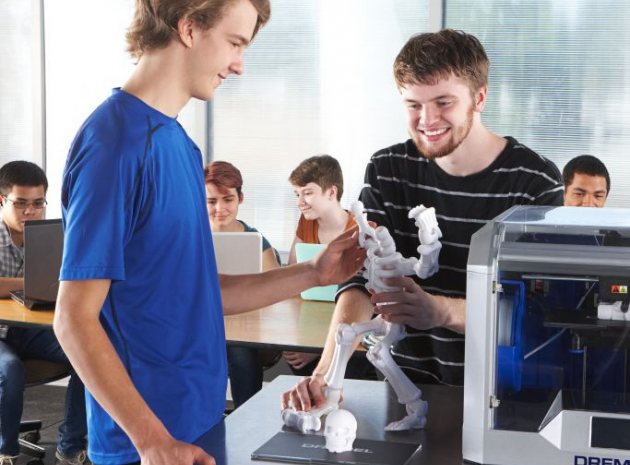If a traditional printer is a ‘tool’ in the same way a hammer is a tool, then a 3D printer is something else entirely. It’s more like an engine – a driving force that allows students to break down the boundaries of their own imagination and put their insights to use in real-world applications.
Teachers have known for generations that students learn best by doing something, whether it is hands-on problem solving or a science lab exercise. The experience itself helps to make knowledge stick. We retain only 5% of what we hear, but 75% of what we do, which means experiential learning is a more effective way to gain understanding of materials than lecture-based discussions.
The world of 3D is bringing concepts to life in manufacturing and retail, and educators are taking notice. In forward thinking schools around the globe, administrators are employing 3D printers to make abstract concepts from physics, algebra and chemistry.
Bringing concepts to life
In past generations, STEM fields might not have been able to engage students as much as, say, football. The ‘x’s and ‘o’s on the coach’s blackboard came to life on the field every week, while the algebra on the paper in class just sat there.
Today, 3D printing is inspiring the same sort of wonder in STEM fields as some have for the field of athletics. Students are printing designs for cooking tools, inhabiting planets and even inventing new animals.
The prototype
When algebra and chemistry are on paper, many educators think that students close their minds to them because of the fear of failure. A wrong answer means red marks all over the page and lower grades. With the new generation of 3D printing and computer modelling, the ability to create physical prototypes brings equations to life.
Students can see first-hand the anomalies that incorrect equations cause, and they can fix them by a trial and error process that is much more fun than the right/wrong dichotomy of the page.
Gamification of learning
Schoolchildren eat up 3D technology for one reason: they have already been introduced to the technology at home.
One of the most popular types of games, the first-person shooter, is basically a 3D rendering of an environment. In the latest generation of gaming consoles, kids get to engage these worlds even more closely through virtual reality, making the 3D world even more immediate. This ‘training’ creates a natural camaraderie between the modern student and 3D technology.
When 3D printing was introduced to elementary and junior high school students, they were quickly printing out prototypes and creating new versions of examples – they had been doing this for years on the insanely popular building game Minecraft.
Starting early
Administrators in many schools note that students who see the results of their equations and work in 3D physical form tend to take a much more serious view of STEM fields. They want to learn the ancillary skills to make their prototypes, so they take to algebra and other mathematical disciplines much more readily.
3D printing as an enabler
With the advent of 3D printing, experiential learning can be extended to other fields. We can all picture models of the atom or skeletons hanging in the science lab, but imagine if we could make any shape quickly in the classroom.
Instead of just looking at a plastic skull, we could make alternate versions to handle, rotate, measure and test to better understand why our heads are shaped the way they are. Instead of just working with the equations that calculate the strength of different shaped beams in a bridge, we can make them to any specification that we want and measure how strong or flexible they are.
Andrew Cluney is regional brand manager at Dremel UK For more information about 3D printing in the classroom, see Dremel’s videos on YouTube.







